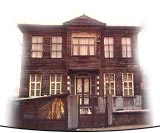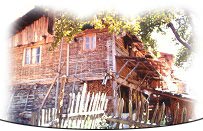Folk Architecture
Folk Architecture
 Folk
architecture is the living environment people have created for themselves. We
can define local architecture as an architecture formed in the process of
anonymous design which later becomes traditional under the influence of various
factors.
Folk
architecture is the living environment people have created for themselves. We
can define local architecture as an architecture formed in the process of
anonymous design which later becomes traditional under the influence of various
factors.
Local architecture is one of the most important sources of information to
allow us to understand and explain the ideas, views, traditions, customs and
belief systems, family and relationships and neighbourhood relations of a
community.
Official and monumental buildings are considered independent of local
architecture. However, such buildings as baths, fountains, coffee houses, etc.
are also included within the framework of local architecture in Türkiye.
To examine local architecture, one must start with the natural and social
environment and the construction materials and techniques of local architecture.
- Economic structure,
- Lifestyle,
- Standards of judgment
- Relations within the Family and with Relatives,
- Effects of customs, local rules, traditions and beliefs on
Architectural elements all need to be considered in the context of local
architecture. Local architecture has no monumental purpose; in other words,
structures are not built for the purpose of leaving a deliberate trace behind
them. Typical construction materials from the region in question are used in
local architecture. Therefore, similar buildings can be seen in places which
have similar regional conditions and geological structures. The buildings that
make up local architecture are built by their owners or local artisans.
Generally speaking, local architecture has an anonymous structure. Thus, local
architecture is also called “Anonymous Architecture.”
A folklorist will look at a house within the framework of these criteria:
- The natural environment where it is constructed,
- Functions,
- Equipment, tools and construction materials used,
- Construction technique,
- Common practice and belief in the surrounding area.
Unless there is a major change in economic and social structure, local
architecture remains unchanged for many years. Products of local architecture
which have not been created under a specific project have specific, identifiable
features in seven regions of Anatolia.
The Ministry of Culture’s, Research and Development of Local Cultures General
Directorate has been carrying out studies in this field. Products of local
architecture have been documented with slides, and construction techniques have
been archived by examining their functions and determining the degree of
traditionality in discussions with local craftsmen. Along with the changing
cultural and social structure, a rapid alteration has been observed in local
architecture. In order to survive, local architecture needs to be reinterpreted
and evaluated by ascribing new functions to it without contradicting its main
structural intentions and purposes.
 New
buildings should be created in order to meet the requirements of the changing
cultural structure, along with a response to traditional lifestyle. Local people
who are ill-informed about the beauty and nature of products of local
architecture have rapidly been pulling these buildings down and constructing new
buildings which are extremely unhealthy for themselves. People need to be better
informed on this subject. Man is a whole together with his environment. Türkiye
has recently entered a rapid urbanisation process, together with technological
developments and a changing cultural structure. In order for buildings to be
incorporated into this process, the following are essential:
New
buildings should be created in order to meet the requirements of the changing
cultural structure, along with a response to traditional lifestyle. Local people
who are ill-informed about the beauty and nature of products of local
architecture have rapidly been pulling these buildings down and constructing new
buildings which are extremely unhealthy for themselves. People need to be better
informed on this subject. Man is a whole together with his environment. Türkiye
has recently entered a rapid urbanisation process, together with technological
developments and a changing cultural structure. In order for buildings to be
incorporated into this process, the following are essential:
- Architects, scientists and researchers should have sufficient knowledge of
the social sciences,
- Works should be carried out with the assistance of folklorists, starting
from the planning phase right through to completion,
- For a correct and true interpretation of changing cultural structures,
folklorists and sociologists should make joint evaluations and offer
suggestions to architects, researchers and scientists.
Nature is complemented by man. Right from the very earliest times, man has
built a dwellings and shelters for himself, and will continue to build houses in
the future. Those houses are the most important source of information regarding
cultural structure.
Upper Picture: Sakarya
Picture Below: An example of the "Ardanuc Cakatura" building technique.